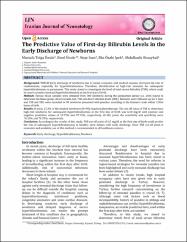The Predictive value of first-day bilirubin levels in the early discharge of newborns
Künye
Unsur MT, Unsur E, Inan N, Ipek IO, Bozaykut A. The Predictive value of first-day bilirubin levels in the early discharge of newborns. Iranian Journal of Neonatology 2015; 6(3): 1-5Özet
Objective: Early discharge of newborns is essential because of social, economic an medical reasons in our area, but it increases readmission rates especially for hyperbilirubinemia. Hence, predicting the high risk neonates for subsequent hyperbilirubinemia is required. This study was designed to investigate which level of total serum bilirubin (TSB) at the first day could be used to predict hyperbilirubinemia. Methods: The venous blood samples obtained from 300 newborns at post-partum 24±6 hours for blood group, direct coomb’s, TSB and direct bilirubin level (DBL). These newborns were followed up during 5- day and TSB and DBLwere detected in 90 newborns with jaundice again according to Kramer dermal zones at 120±6 hours of age. Results: In 23.3% of 90 newborns phototherapy was needed. The cut off value of TSB at the first day to define newborns at high risk for subsequent hyperbilirubinemia was 6.50 mg/dl with positive predictive value 19.75%, negative predictive value 97.72%. At that point sensitivity was 76.19%, specificity was 76.70%. Conclusion: The cut-off point of 6.5 mg/dl of TSB at the first day might be used to predict subsequent hyperbilirubinemia risk at healthy, full-term early discharged newborns as the test is economic and available in all healthcare units.


















